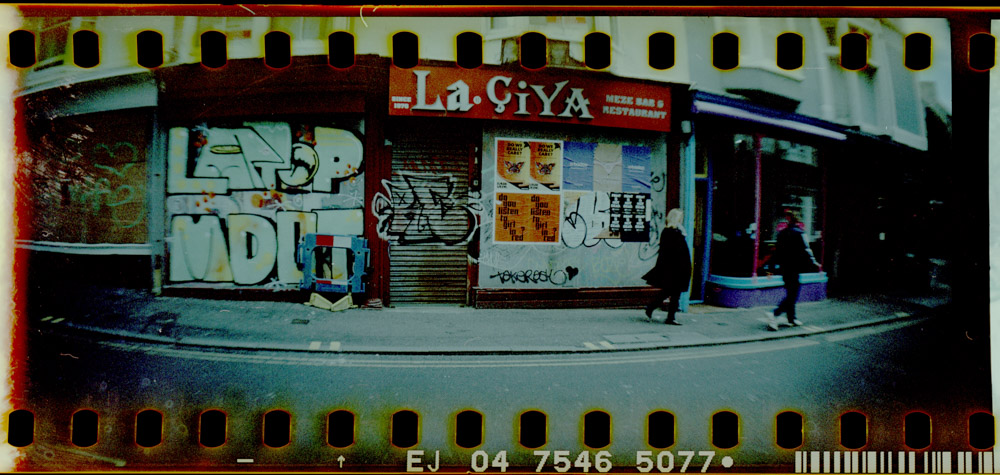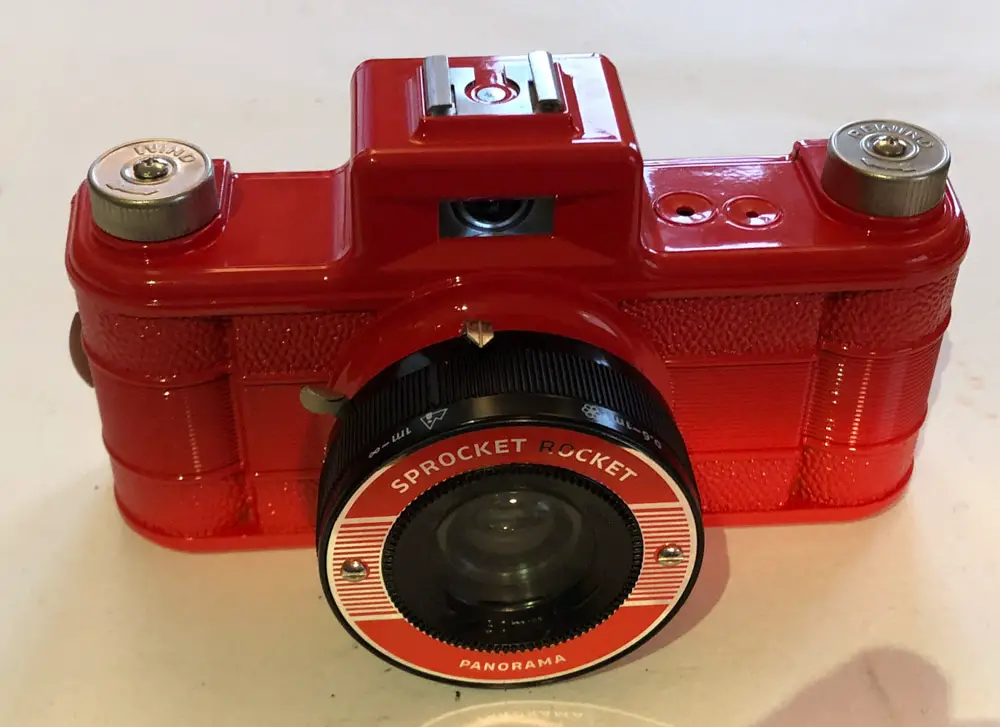5 Frames of Kodak VISION3 500T 5219 developed in RA-4 chemistry (35mm Format / EI 500 / Lomography Sprocket Rocket) – by Steve Jones
Like many analogue fans the Coronavirus lockdowns and restrictions, which started here in the UK in March, have both created time to fill and the means of filling it. I have been trying out new films and processes and using various old cameras in my collection dating back to the 1880s. Whilst ordering film online I came across the Lomography Sprocket Rocket for sale new at £60; the same as a few rolls of film or a box of Multigrade paper. It looked like a lot of potential fun for little money so I bought one.
The Sprocket Rocket takes 35 mm film, has a 30mm fixed lens, and takes frames 72mm wide and virtually the whole height of the film, which include all the edge markings and — as you might expect from the camera’s name — sprocket holes. A mask is included which will give you frames measuring 72 x 24mm if you wish. Technically sophisticated it is not!

The lens’ aperture choice is f/10.8 (largest) or f/16. The camera has shutter speed options of 1/100 or B. Focus is set via zone focus with options of 0.6 to 1m or 1m to infinity. There is a hot shoe, exposure counter, tripod socket, knobs for both wind and rewind, and an indicator when to stop winding.
I first put a couple of C-41 films through it and then paid a visit to Nik&Trick in Folkestone to get some respooled movie film. These pics were shot on Kodak VISION3 500T which I then home-processed using RA-4 colour print chemistry, as recommended by Nik&Trick.





The Sprocket Rocket was fun to use in the colourful seaside city of Brighton, where visitors to the pier were much depleted due to the virus. It’s certainly no rival to the Hasselblad XPan (available used for £3000+). The centre of the frame is reasonably sharp -– akin to a basic 1960s Instamatic –- but details dissolve very rapidly towards the sides. With only two exposure settings you have to rely on the film’s exposure latitude so in mixed lighting the film comes out with a lot of very thin and very dense frames. This puts expert scanning at a premium – these images were produced on a venerable Epson Perfection V700 after a lot of inexpert fiddling by me. The scans also suffered from the negatives curling on the scanner platen.
The yellow/red edges may be due to inadequate remjet removal from the movie film around the grooves in the spiral. This does not happen with non-Remjet C-41 films, but for me, this sort of randomness is the whole reason for playing around with analogue. If I want perfect predictability I’ll use my Sony A7.
i love my Sprocket Rocket. The only sensible improvements would be another shutter speed around 1/30 and a cable release socket.
~ Steve
Submit your 5 Frames… today
Get your own 5 Frames featured by submitting your article using this form or by sending an email via the contact link at the top of the page.
Share your knowledge, story or project
The transfer of knowledge across the film photography community is the heart of EMULSIVE. You can add your support by contributing your thoughts, work, experiences and ideas to inspire the hundreds of thousands of people who read these pages each month. Check out the submission guide here.
If you like what you’re reading you can also help this passion project by heading over to the EMULSIVE Patreon page and contributing as little as a dollar a month. There’s also print and apparel over at Society 6, currently showcasing over two dozen t-shirt designs and over a dozen unique photographs available for purchase.








4 responses to “5 Frames of Kodak VISION3 500T 5219 developed in RA-4 chemistry (35mm Format / EI 500 / Lomography Sprocket Rocket)”
Lovely images, with great colors. Thanks for sharing!
Out of curiosity, why did you buy a ‘new expensive camera’ instead of using e.g. an Afga Clack and a 135 to 120 adapter? It gives a 90mm panorama and has a cable release and costs rather to nothing. Just curious, no judgement.
It was a random encounter on Analogue Wonderland website while checking out film and at £60 i didn’t spend too long thinking about it. I later got a 35/120 adaptor which I use in my Fuji 645. The Sprocket Rocket is also small and light compared with my 6×9 Bessa and then I wouldn’t have the extreme view angle, just a slice of a regular one.
I’m probably biased because I love the Sprocket Rocket, but I LOVED LOVED your shots with it! I’ll have to diginto my film cache and see if I still have any Vision 500, you’ve been an ispiration!
I you want to make your photographic life equally heavy get Horizon Kompakt. maybe you will find out quickly why only superignorants can creat such a supercrippled rotapancam. have my experiece made with widelux 1500(never buy it). see http://www.rotatingpanoramiccameras.tk endless stories about problems with horizont/horizon, widelux etc. rotapancams. tipps and trick. allow cookies. no need to login.